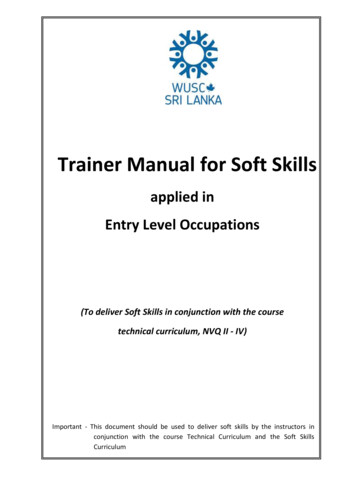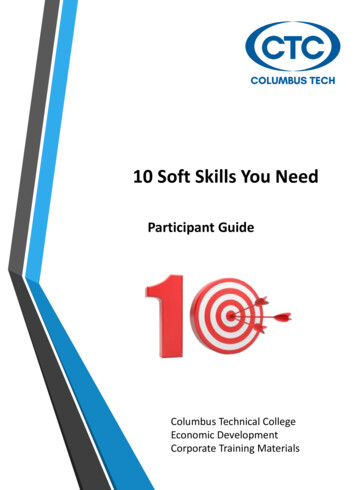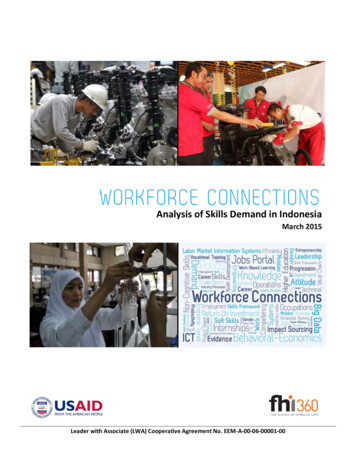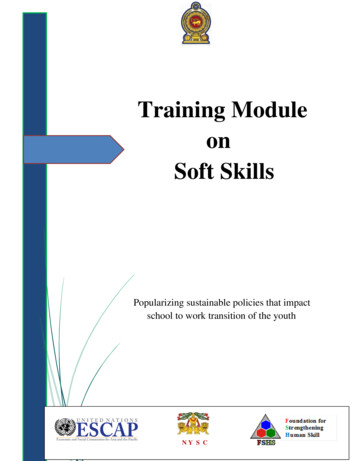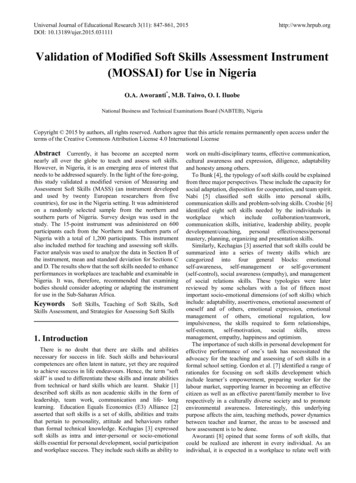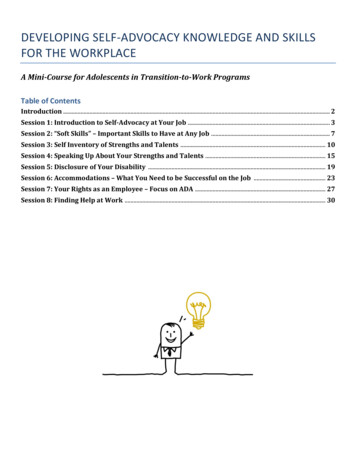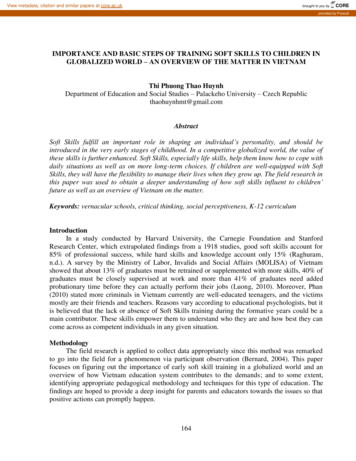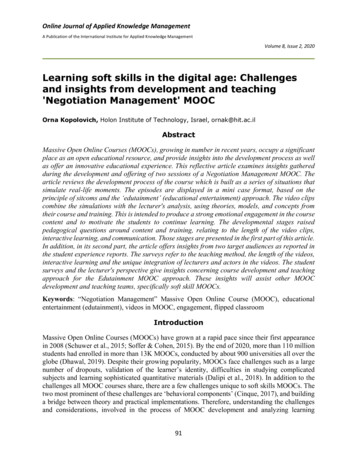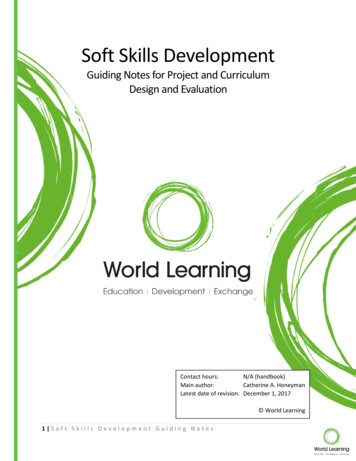
Transcription
Soft Skills DevelopmentGuiding Notes for Project and CurriculumDesign and EvaluationContact hours:N/A (handbook)Main author:Catherine A. HoneymanLatest date of revision: December 1, 2017 World Learning1 Soft Skills Development Guiding Notes
AcknowledgmentsThis document was developed in collaboration with a team from across World Learning’s internationaldevelopment and exchange programming. Thanks to the following people for their contributions atdifferent points during several rounds of discussion and editing: Rizwaan Akhtar, Wasima Asadi, AndrewFarrand, Meri Ghorkhmazyan, Cari Graves, Christopher Iverson, Josephine Kennedy, Linda Keuntje, HamzaKoudri, Jessika Macias, Andy Noonan, Simon Norton, Neil O’Flaherty, Amy Pallangyo, Lisa Posner, AmySchwenkmeyer, Lois Scott-Conley, Abdallah Talhi, and Roya Zahed.This document represents a work in progress, building off recent research from the USAID YouthPowerinitiative, as well as other sources. It is likely that revisions will be made in the future as the evidence baseevolves. Comments and suggestions can be sent to catherine.honeyman@worldlearning.org.Published in Washington, DC by World Learning, Inc.: December 1, 2017. All rights reserved. This work islicensed under a Creative Commons Attribution-NonCommercial-ShareAlike 4.0 International License.2 Soft Skills Development Guiding Notes
Soft Skills DevelopmentGuiding Notes for Project and Curriculum Design and EvaluationTable of ContentsAcknowledgments. 2How to Use this Guide . 4Tools for Soft Skills Development. 5Soft skills checklist . 5Pedagogical inventory . 6Assessment guidance . 7Specific skill development plan . 9Overall skills development framework . 10References for further reading . 11Annexes . 12Annex I: Quick Reference—Seven Key Soft Skills . 13Annex II: Dictionary Definitions of Soft Skills Terms . 14Annex III: Soft Skills Pedagogical Examples. 18Annex IV: Example Pedagogical Observation Form . 23Annex V: Example Soft Skills Student Observation Rubric . 25Annex VI: Using the Chinese Positive Youth Development Scale . 27Annex VII: List of Recent World Learning Programs that Build Soft Skills . 323 Soft Skills Development Guiding Notes
How to Use this GuideThis guide is intended to encourage continuous improvement in the quality of programs that aim to build“soft skills”, or “life skills”. The tools included here can be used both for design and for evaluation. Thetools in pages 5-10 should be printed out for note-taking either individually or in a workshop setting. Theremainder of the document offers details that can be referenced in soft copy.For Project or Curriculum DesignThis guide contains a set of checklists and guiding questions to assist in project and curriculum designrelated to the development of soft skills.Use the soft skills checklist to determine which skills are most important for the project’s goals, thepedagogical inventory to think through the most effective pedagogical approaches to soft skillsdevelopment in your project or curriculum, and the assessment guidance to become familiar with the keycharacteristics of an effective soft skills assessment.Once you have gone through these background steps, use the specific skill development plan to thinkthrough project and curriculum needs for each specific soft skill to be developed. You may need to printmore than one copy of page 8 to accomplish this.Finally, use the overall skills development framework to link all these elements into a coherent approach.For Project Evaluations and Technical AssistanceThe same tools described above can also be used for the purposes of evaluating an existing project orcurriculum, or providing technical assistance for their improvement.Use the soft skills checklist to evaluate whether all the most important soft skills are being addressed bythe curriculum, the pedagogical inventory to evaluate to what extent the current curricular approachreflects effective pedagogical practices for soft skills development, and the assessment guidance, startingwith Step 3, to evaluate the appropriateness, validity, and reliability of the assessment tools being used.Next, use the specific skill development plan to think through changes that might need to be made for eachspecific soft skill that is a focus of the project or curriculum.Finally, use the overall skills development framework to create an overarching plan for improvement.For EveryoneThis guide also provides detailed additional guidance of relevance for both design and evaluation. A list ofreferences for further reading offers further insight into issues of soft skills prioritization, pedagogy, andassessment. On definitions, Annex I provides a Quick Reference guide to definitions of the seven key softskills identified as consistently linked to positive outcomes across several types of youth programming,and Annex II presents a list of dictionary definitions for each of the soft skills terms contained in the guide.On pedagogy, Annex III provides further description and examples of effective pedagogical practices forsoft skills development, while Annex IV offers an example pedagogical observation rubric. On assessment,Annex V provides an example of a soft skills observation rubric for assessing students’ skills, and Annex Vgives guidance for using a written soft skills assessment that has already been validated internationally,the Chinese Positive Youth Development Scale. Finally, Annex VI lists recent World Learning projects thathave a soft skills development component.4 Soft Skills Development Guiding Notes
Tools for Soft Skills DevelopmentSoft skills checklistWhich soft skills are important to your project? Summarize your project goals, then select any soft skillsthat are crucial to these goals, or are of secondary importance. Note that the categories are provided onlyfor organizational purposes, and are not rigid. For definitions, see Annex I and Annex II of this document.Project GoalsList of Soft SkillsPsychosocial and emotional health Awareness of personal needs and self-care Emotional intelligence Positive self-concept, realistic self-esteem, belief in self-efficacy Skills for coping with the effects of traumatic and toxic stress Resilience in the face of setbacksIntra-personal skills Self-control, emotional regulation, and self-discipline Conscientiousness, dutifulness, and reliability Truthfulness, honesty, and trustworthiness Attention to detail and/or Seeing the big picture Goal-orientation and initiative Perseverance, determination, and grit Growth mindset, and recognizing need for improvementInter-personal (social) skills Cross-cultural competence, and valuing diversity of perspectives Respecting and expressing appreciation for others; kindness Demonstrating context-appropriate behavior, reflecting social norms Empathy and ability to notice the effects of one's actions on others Tolerance for disagreement, conflict management and resolution Agreeableness, collaboration, and teamwork LeadershipCommunication Effective listening and seeking to understand others' perspectives Ability to effectively express and understand knowledge and ideas through reading and writing: written communication through speaking and presenting: oral communication in online and digital contexts: digital literacy and etiquette Awareness of non-verbal communication norms and cues Non-violent negotiation and persuasion Communicating across age groups, cultures, or identity groupsHigher-order thinking skills Critical thinking and evaluation Information-seeking, research, and independent learning Synthesis, creativity, problem analysis, and problem-solving Decision-making Self-reflection and learning from experienceCivic engagement and social enterprise skills Global and local awareness (issues, challenges, priorities) Vision, ability to imagine something new or improved Social responsibility and willingness to take constructive action Researching relevant issues (desk research, interviews, observation) Financial literacy, budgeting, and financial management Marketing, creating coalitions, advocacy, and eliciting supportEmployability skills (in addition to other soft skills listed above) Job search skills: self-presentation, networking, CVs, interviewing, etc Workplace-appropriate verbal and written communication styles Navigating workplace roles and relationships Judging appropriate styles of dress, decoration, and personal behavior Punctuality, work planning, and meeting deadlines5 Soft Skills Development Guiding NotesCrucialSecondaryN/A
Pedagogical inventoryBelow is a list of key elements of quality project design and effective pedagogy for soft skills development.Further information on what each principle looks like in practice, and how it helps, can be found in AnnexIII, and Annex IV offers an example rubric that can be used for facilitator observations or self-assessments.For Planning: Use the space next to each principle to write initial ideas for project or curriculum design.For Evaluation: Does your project meet the standards described below? What areas need improvement?Pedagogical PrinciplesSpace for Planning or EvaluationN/ANotat allSome-whatYes,mostlyYes,fully1. Develop a safe, caring, and supportive environment that allowsyouth to express themselves and take on challenges—includingthe risk of mistakes—without fear of ridicule.2. Build underlying skills of social awareness to help participantsidentify, evaluate, and—where appropriate—follow the normsand standards of particular social contexts.3. Explicitly discuss what each soft skill is, why it is important, andwhat it looks like in practice. Define new concepts. Point outspecific soft skills when they are enacted or observed in action.4. Promote skills development through experiential learning incycles of concrete action, reflective analysis, relating theexperience to abstract concepts, and planning for furtheraction—including both prearranged/contrived exercises anddemanding but achievable real-life experiences.5. Provide consistent positive feedback when youth demonstratecore soft skills, closely connected to the positive action itself.Consider employing negative consequences when necessary.6. Connect it all together into an overarching framework ofprinciple and purpose that helps youth understand the largerpicture of why developing these skills is important, and helpsthem apply broad principles to make decisions in new situations.7. Promote integration across the different learning contexts towhich youth are exposed—family, community, educationinstitution, workplace, etc—with clear and consistent standardsacross them.8. Ensure that staff model in their own daily life the soft skillsbeing promoted. Support staff in recognizing and addressing anypersonal areas for improvement.9. Promote strong mentorship relationships between adults andyouth and among youth themselves, which are meaningful andcaring, and in which youth are seen as valued contributors.10. Allow for the development of soft skills over time and in avariety of situations, not just in single lessons. Employ multipleexperiential learning cycles of action and reflection.Key takeaways:6 Soft Skills Development Guiding Notes
Assessment guidanceMeasuring soft skills can be challenging, especially as these skills are naturally expressed in action, incomplex social environments (Wilson-Ahlstrom, Yohalem, DuBois, & Ji, 2011). Determining an appropriateassessment method depends on many factors, including the purpose of the assessment. In many contexts,it can be important to help participants set goals and assess themselves. Some projects also requirecollecting assessment data for purposes of monitoring and evaluation. In general, assessments should be:Feasible Can be accomplished with the available time,resources, and personnel, considering factors such asthe number of respondents and the effort necessary togather and process the dataValid The assessment measure (which is always a "proxy"representing a more complex reality) accuratelyreflects what it means to possess a given skill or set ofknowledge in the real worldReliable The assessment produces consistent measurements orscores for the same skill level, regardless of factorssuch as who is taking it, who is administering it, whereit is administered, and who is grading itDifferent assessment methods present different strengths and weaknesses along these three factors.MethodObservation: Assesshow people behavein everydaysituations, or inresponse to aparticular task.Project: Measure thesuccessfulcompletion of aproject that requiresthe use of certainskills.Written or oralassessment: Posequestions that testfor certainknowledge,attitudes, and skills.FeasibilityValidityReliability Feasible only forsmaller numbers ofrespondents, sinceobservation requiresmore time and directattention from theassessor. Soft skills assessmentcan be integrated as partof the achievement ofother course objectives,but completing/gradingprojects takes time. With a well-designedrubric defining thebehaviors to be observedand their scoring,observation comes closestto measuring the skill itselfin practice. Can be a highly authenticassessment method—butmeasurement may beunclear if the projectrequires other skills orresources that some youthdo not have. Soft skills do not easilytranslate into words. Selfreported measures areunreliable.Literacy/language skills mayalso get in the way ofaccurate measurement. Achieving reliabilityrequires a well-designedrubric and significanttraining of assessors toensure that they scoreobserved behaviors insimilar ways. Achieving reliabilityrequires a clear rubric ofskills to be assessed andassessor training to ensureconsistent scoring acrossprojects reflecting similarskills levels. Reliability is fairly easyto test and improvethrough piloting. Relatively easy toaccomplish with manypeople when closed(multiple choice)responses are used.7 Soft Skills Development Guiding Notes
Use the following steps to create—or help participants create—a rubric or a written assessment.Skip to Step 3 if you want to evaluate an existing tool. You may also refer to Appendix IV, which containsan example soft skill observation rubric, and to Appendix V, which provides detailed guidance for how touse the CPYDS, a written assessment for some soft skills that has already been validated internationally.Skill Name:Step 1. Answer the following questions:How does a person with this skillbehave? (contrast to someonewithout the skill)How does a person with this skillthink and feel? (contrast tosomeone without the skill)Does exercising this skill requiresome knowledge? (contrast tosomeone without the skill)Step 2: Create a Rubric or Written AssessmentCreate a rubric for observations or projectsCreate a written assessment Write the skills to be assessed in the first column of a tableand leave three or four blank columns to the right. In the far right column, write context-relevant observablebehaviors or results that demonstrate excellence in thatskill. Fill in the other columns with progressive examples oflower skill levels. Determine whether there are any behaviors that you wantto count, such as "the number of times a student offers anidea" and provide a space for recording that result. Having multiple measures of the same construct helpsimprove the validity of written assessments: Write a few questions asking about the respondent'sbehavior related to the soft skill in the past day or week. Write a few related statements of feeling or attitudes thatcorrespond to the soft skill. Write a few questions that require relevant knowledge. Randomly mix the questions so that related items are not allfound together. Use a Likert scale for response options.Step 3: Pilot and check for validity and reliabilityCircle the method(s) in blue that you are using, then check off the criteria that the tool meets.Observation:Project-based:Assessing everydayactions andinteractions, focusingon observablebehaviorsMeasuring thesuccessful completionof a project thatrequires the use ofcertain skills Validity: Do you havea well-defined rubric ofobservable behaviorsthat are clearly linked tothe skill in question? Validity: Do you havea well-defined rubric?Have you accounted forbackground skills thatmay pose a blockage tosome students? Validity: Does each question adequately reflect the skill itself? Can this question only be answered by someone who possesses the skill? If you administer your project-based or written assessment to individualswho, according to your observation, already exhibit the soft skill inquestion, do they provide the “correct” answer? If not revise. Reliability: Dodifferent assessorsreliably evaluate thesame behaviors in thesame way, using yourrubric? Reliability: Dodifferent assessorsreliably evaluate theproject's skill levels inthe same way, usingyour rubric? Reliability: Does the assessment produce consistent results? Do the different items on the assessment that are intended to measurethe same thing produce the same results for the same person? If the same individual takes the assessment on two subsequent days, arethe results identical or nearly identical?Written or oral assessment:Linking the skill itself to certain verbal questions. Such questions may be:Knowledge-based, primarilyfocused on informationPsychometric assessmentsof personality or attitudeScenario-based, asking for areaction to a hypotheticalsituationAre revisions necessary?8 Soft Skills Development Guiding Notes
Specific skill development planUse the following questions to create a skill-specific design plan, or a plan for curriculum improvement.Use one copy of this page for each core soft skill targeted in the program.Name and define the soft skill to be developed, and the purpose or importance of developing it.What kinds of teaching and learning processes, including experiences, are generally needed todevelop the skill?Out of these options, what specific learning experiences do you intend to include in the project?Keep in mind that some cross-cutting and integrated elements may be helpful or even necessary.How can the development of these skills be measured? How can participants measure their progress?Which specific assessment approach will you follow, and how will you ensure validity and reliability?How will the development of this skill or cluster be linked to the development of other soft skills thatare important to the project goals, in an overarching and consistent approach?9 Soft Skills Development Guiding Notes
Overall skills development frameworkUse this page to create an overall soft skills development framework. First describe the overall learningobjectives and list the program’s core target soft skills below. Then summarize the inter-linked learningexperiences that will lead to the development of these skills, as well as how they will be assessed.Overall Learning Objectives:Learning sonalskillsInterpersonal(social) engagementand socialenterpriseskillsEmployability skills10 S o f t S k i l l s D e v e l o p m e n t G u i d i n g N o t e sAssessment Methods:
References for further readingGalloway, T., Lippman, L., Burke, H., Diener, O., & and Gates, S. (2017). Measuring soft skills and life skillsin international youth development programs: A review and inventory of tools. Washington, DC:USAID YouthPower: Implementation.Gates, S., Lippman, L., Sadowen, N., Burke, H., Diener, O., & and Malkin, M. (2016). Key Soft Skills forCross-Sectoral Youth Outcomes. Washington, DC: USAID YouthPower: Implementation. Retrievedfrom s-cross-sectoral-youth-outcomesKautz, T., Heckman, J., Diris, R., ter Weel, B., & Borghans, L. (2014). Fostering and measuring skills:Improving cognitive and non-cognitive skills to promote lifetime success. OECD.Lippman, L., Ryberg, R., Carney, R., & Moore, K. (2015). Key "soft skills" that foster youth workforcesuccess: Toward a consensus across fields. WorkForce Connections (FHI 360/USAID).Reimers, F., Chopra, V., Chung, C., Higdon, J., & O'Donnell, E. (2016). Empowering global citizens: A worldcourse. Charleston, South Carolina: CreateSpace.Shek, D., Siu, A., & Lee, T. Y. (2007). The Chinese Positive Youth Development Scale: A Validation Study.Research on Social Work Practice, 380-391.Soares, F., Babb, S., Diener, O., Gates, S., & and Ignatowski, C. (2017). Guiding principles for building softskills among adolescents and young adults. Washington, DC: USAID YouthPower Implementation.Stanchfield, J. (2016). Tips and tools for the art of experiential group facilitation (Second ed.). Bethany,Oklahoma: Wood N Barnes.Wilson-Ahlstrom, A., Yohalem, N., DuBois, D., & Ji, P. (2011). From soft skills to hard data: Measuring youthprogram outcomes. The Forum for Youth Investment.11 S o f t S k i l l s D e v e l o p m e n t G u i d i n g N o t e s
AnnexesAnnex I: Quick Reference-Seven Key Soft SkillsAnnex II: Dictionary Definitions of Soft Skills TermsAnnex III: Soft Skills Pedagogical ExamplesAnnex IV: Example Pedagogical Observation RubricAnnex V: Example Soft Skills Student Observation RubricAnnex VI: Using the Chinese Positive Youth Development ScaleAnnex VII: List of Recent World Learning Programs that Build Soft Skills12 S o f t S k i l l s D e v e l o p m e n t G u i d i n g N o t e s
Annex I: Quick Reference—Seven Key Soft SkillsThe USAID YouthPower Action Initiative has identified sevenkey soft skills or skill areas for cross-sectoral youthdevelopment (Soares, Babb, Diener, Gates, & and Ignatowski,2017) (Lippman, Ryberg, Carney, & Moore, 2015). These sevenskills are highlighted because of the research supportindicating that they lead to positive outcomes in at least twoof the following domains: workforce success, sexual andreproductive health, and violence prevention.Below are definitions of these soft skills.Definitions of the Key Seven Soft Skills Identified by the USAID YouthPower Action Initiative1Higher order thinking skills Skills encompassing problem solving, critical thinking, and decision making. These skills may reflect thesame underlying skill set, which is the ability to take in information from multiple sources, identify theissue(s), evaluate potential options, and reach an appropriate conclusionSelf-control The ability to delay gratification, control impulses, direct and focus attention, manage emotions, andregulate behaviorsPositive self-concept A realistic awareness of oneself and one’s abilities, strengths, and potentialSocial skills A cluster of skills necessary to get along well with others, including: Respecting and expressing appreciation for others (requiring cultural sensitivity) Demonstrating context-appropriate behavior according to social norms Using a range of skills or processes aimed at resolving conflictCommunication The ability to effectively express and understand knowledge and ideas. Includes one’s ability tonegotiate and persuade, as well as transmit and interpret knowledge. Types of communication includelistening, and skills in verbal, non-verbal, and written communication.Empathy The ability to feel and understand what someone else is feeling.Goal-orientation The motivation and ability to make reasonable plans and take action toward desired goals1These definitions are summarized in Soares et al (2017, p. 13), drawing primarily on definitions developed inLippman et al (2015).13 S o f t S k i l l s D e v e l o p m e n t G u i d i n g N o t e s
Annex II: Dictionary Definitions of Soft Skills TermsMany soft skills are defined in different ways in different contexts and publications, using a range ofrelated terms and varying ways of clustering related skills together. The table below presents dictionarydefinitions for each of the soft skills terms referenced in the Soft Skills Checklist earlier in this document,with each individual term organized in alphabetical order. Cross-reference to the original skill area (asorganized in the Checklist) appears in the column to the right. These definitions are provided from theMerriam-Webster* and Cambridge† dictionaries for illustrative purposes, or when necessary fromWikipedia‡; in most cases, multiple different definitions exist in the literature for the same term.Soft SkillAgreeablenessAppreciationAttention to anagementConflict l A tendency to be compassionate and cooperative ratherthan suspicious and antagonistic towards others.‡Recognizing someone's worth as a person or showing youare grateful for something that person has done.†Thorough, accurate, and consistent when accomplishing atask; small details are not overlooked.Knowledge and understanding that something ishappening or exists* [for example awareness of local orglobal social or environmental issues and problems]Working together or with someone else for a specialpurpose.†The process by which messages or information is sentfrom one place or person to another, or the messageitself†. Includes oral and written communication.The process of limiting the negative aspects of conflictwhile increasing the positive aspects of conflict.‡The methods and processes involved in facilitating thepeaceful ending of conflict and retribution.‡Feeling a moral responsibility to do your work carefullyand to be fair to others†; The personality trait of beingcareful, or vigilant. A desire to do a task well, and to takeobligations to others seriously.‡To deal with problems or difficulties, especially with adegree of success.†The ability to produce original and unusual ideas, or tomake something new or imaginative. †The process of thinking carefully about a subject or idea,without allowing feelings or opinions to affect you†; theobjective analysis of facts to form a judgment.‡The knowledge, skills, and affect/motivation that enableindividuals to adapt effectively in cross-culturalenvironments. The ability to communicate effectively andappropriately with people of other cultures. ‡The way of life of a particular people, especially as shownin their ordinary behavior and habits, their attitudestoward each other, and their moral and religious beliefs.†14 S o f t S k i l l s D e v e l o p m e n t G u i d i n g N o t e sSkill AreaInter-personal(social) skillsInter-personal(social) skillsIntra-personal skillsCivic engagementand socialenterpriseInter-personal(social) skillsCommunicationInter-personal(social) skillsInter-personal(social) skillsIntra-personal skillsPsychosocial andemotional healthHigher-orderthinking skillsHigher-orderthinking skillsInter-personal(social) skillsInter-personal(social) skills
Decision-makingDeterminationDigital egulationEmpathyEtiquetteEvaluationFinancial literacyGoal-orientationGritGrowth LeadershipThe cognitive process resulting in the selection of a beliefor a course of action among several possibilities.‡The ability to continue trying to do something, even if it isdifficult.†The set of competencies required for full participation in aknowledge society. It includes knowledge, skills, andbehaviors involving the effective use of digital devices suchas smartphones, tablets, laptops and desktopPCs forpurposes of communication, expression, collaboration andadvocacy.‡Filled with or motivated by a sense of duty, proceedingfrom or expressive of a sense of duty, a dutiful effort*;Obedient or (of an action) done because it is necessary orexpected.†The ability to understand the way people feel and reactand to use this skill to make good judgments and to avoidor solve problems†; includes awareness of one’s ownemotions.The ability to respond to the ongoing demands ofexperience with the range of emotions in a manner thatis socially tolerable and sufficiently flexible to permitspontaneous reactions as well as the ability to delayspontaneous reactions as needed.‡The ability to share someone else’s feelings orexperiences by imagining what it would be like to be inthat person’s situation.†The set of rules or customs that control accepted behaviorin particular social groups or social situations.†to j
soft skills development, while Annex IV offers an example pedagogical observation rubric. On assessment, Annex V provides an example of a soft skills observation rubric for assessing students’ skills, and Annex V gives guidance for using a written soft skills as
